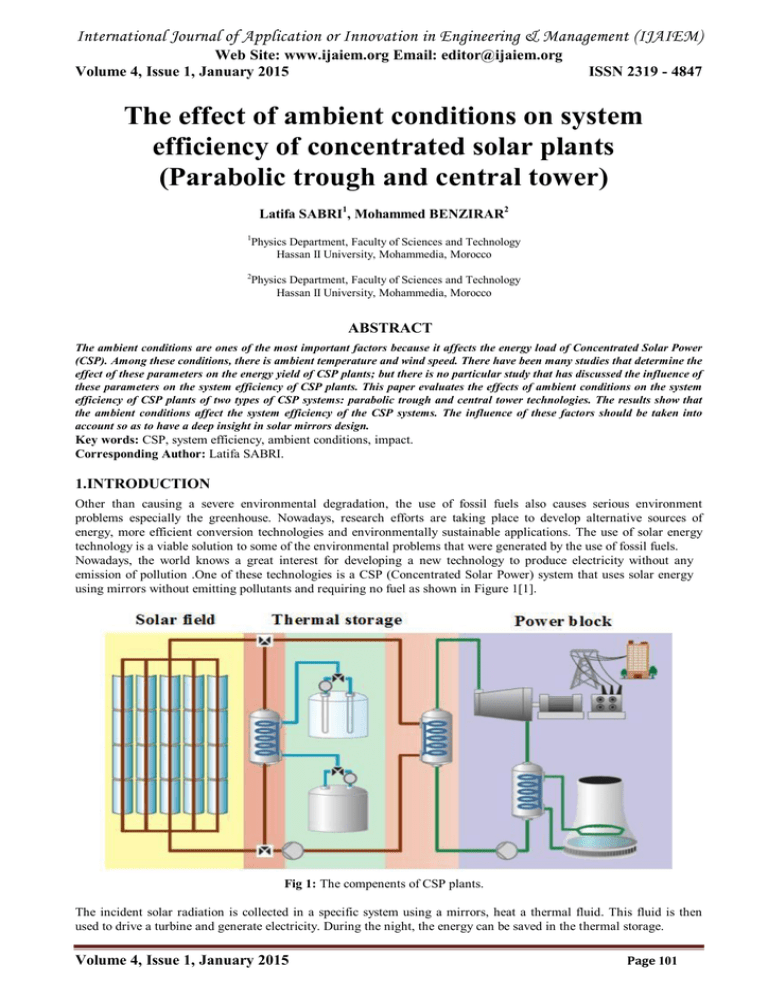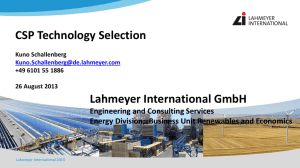The effect of ambient conditions on system
advertisement

International Journal of Application or Innovation in Engineering & Management (IJAIEM) Web Site: www.ijaiem.org Email: editor@ijaiem.org Volume 4, Issue 1, January 2015 ISSN 2319 - 4847 The effect of ambient conditions on system efficiency of concentrated solar plants (Parabolic trough and central tower) Latifa SABRI1, Mohammed BENZIRAR2 1 Physics Department, Faculty of Sciences and Technology Hassan II University, Mohammedia, Morocco 2 Physics Department, Faculty of Sciences and Technology Hassan II University, Mohammedia, Morocco ABSTRACT The ambient conditions are ones of the most important factors because it affects the energy load of Concentrated Solar Power (CSP). Among these conditions, there is ambient temperature and wind speed. There have been many studies that determine the effect of these parameters on the energy yield of CSP plants; but there is no particular study that has discussed the influence of these parameters on the system efficiency of CSP plants. This paper evaluates the effects of ambient conditions on the system efficiency of CSP plants of two types of CSP systems: parabolic trough and central tower technologies. The results show that the ambient conditions affect the system efficiency of the CSP systems. The influence of these factors should be taken into account so as to have a deep insight in solar mirrors design. Key words: CSP, system efficiency, ambient conditions, impact. Corresponding Author: Latifa SABRI. 1.INTRODUCTION Other than causing a severe environmental degradation, the use of fossil fuels also causes serious environment problems especially the greenhouse. Nowadays, research efforts are taking place to develop alternative sources of energy, more efficient conversion technologies and environmentally sustainable applications. The use of solar energy technology is a viable solution to some of the environmental problems that were generated by the use of fossil fuels. Nowadays, the world knows a great interest for developing a new technology to produce electricity without any emission of pollution .One of these technologies is a CSP (Concentrated Solar Power) system that uses solar energy using mirrors without emitting pollutants and requiring no fuel as shown in Figure 1[1]. Fig 1: The compenents of CSP plants. The incident solar radiation is collected in a specific system using a mirrors, heat a thermal fluid. This fluid is then used to drive a turbine and generate electricity. During the night, the energy can be saved in the thermal storage. Volume 4, Issue 1, January 2015 Page 101 International Journal of Application or Innovation in Engineering & Management (IJAIEM) Web Site: www.ijaiem.org Email: editor@ijaiem.org Volume 4, Issue 1, January 2015 ISSN 2319 - 4847 The main concentrated solar power systems are: The parabolic trough system, the parabolic dish system, the central tower system and linear Fresnel as seen in Figure 2[2]. Fig 2: The different types of CSP systems. Certainly, the performance of these power plants depends on ambient parameters including: ambient temperature, wind speed, direct radiation, etc. Many studies have been done like [3, 4, 5, 6], which determine the impact of the meteorological parameters on performances of CSP plants. In this article, there will be a study of the impact of these parameters on the system efficiency of CSP plants There are models that give the system efficiency of CSP plants from ambient conditions such as this equation [7]: system th ( abs Where abs Tabs 4 hconvection (Tabs Tamb ) field C I DNI th is the thermal efficiency, is the solar field efficiency, (1) abs is the radiative absorptivity of the field abs is the radiative emissivity of the absorber, is the Stefan–Boltzmann constant 5.67 * 10 8 (W/m2K4), Tabs is the absorber temperature, Tamb is the ambient temperature (°C), C the concentration factor, I DNI is the direct irradiation (W/m2) and V is the wind speed (m/s). The convective heat exchange hconvection can be absorber, formulated [8]: hconvection 5.7 3.8 V (2) In which V is the wind speed (m/s). Baseline values given and outlined in Table 1 are used for the receiver efficiency calculation. Table 1.Baseline parameter values used to calculate receiver efficiency in Eq. (1). Volume 4, Issue 1, January 2015 th abs field 0.38 abs C 0.95 0.88 0.6 100 and 1000 Page 102 International Journal of Application or Innovation in Engineering & Management (IJAIEM) Web Site: www.ijaiem.org Email: editor@ijaiem.org Volume 4, Issue 1, January 2015 ISSN 2319 - 4847 2.MATERIALS AND METHODS To obtain the purpose of this paper, parabolic through and central tower type of CSP technologies considered. In order to get the results of this article, the meteorological data are taken from the site of Casablanca, Morocco the 7 August 2012 with the specific parameters mentioned in Table 2 and Figures 3, 4 and 5. Table2. Overview of the meteorological conditions at Casablanca. Latitude 33.37 °N Longitude -7.58 °E Elevation 206 m Time zone GMT 0 Fig3: The direct irradiation in Casablanca on 7 August 2012. Fig4: The ambient temperature in Casablanca on 7 August 2012. Fig5: The wind speed in Casablanca on 7 August 2012. From the figures, it’s seen that the ambient temperature and the direct irradiation increase until midday of the day and then they break down. These meteorological data are used as input to performance simulation software named SAM (System Advisor Model). System Advisor Model (Version 2014.11.4) [9] is a performance and financial model Volume 4, Issue 1, January 2015 Page 103 International Journal of Application or Innovation in Engineering & Management (IJAIEM) Web Site: www.ijaiem.org Email: editor@ijaiem.org Volume 4, Issue 1, January 2015 ISSN 2319 - 4847 designed to facilitate decision making for people involved in the renewable energy industry. SAM PT Physical model is used for calculating the absorber temperature. The front of view of the software SAM is seen in Figure 6. Fig6: The front of view of System Advisor Model. 3.RESULTS The impact of the ambient conditions such as: ambient temperature and wind speed on the system efficiency of CSP plants is summarized in Figures 7, 8 and 9. Fig7: The variation of system efficiency for parabolic trough and central tower with the time of the day 7 August 2012 in Casablanca. Fig8: The variation of system efficiency for parabolic trough and central tower with the ambient temperature in Casablanca. Volume 4, Issue 1, January 2015 Page 104 International Journal of Application or Innovation in Engineering & Management (IJAIEM) Web Site: www.ijaiem.org Email: editor@ijaiem.org Volume 4, Issue 1, January 2015 ISSN 2319 - 4847 Fig 9: The variation of system efficiency for parabolic trough and central tower with the wind speed in Casablanca. From two figures 8 and 9, it’s found that with an increase of ambient temperature and wind speed, the system efficiency of the two types of CSP plants (Parabolic trough and central tower) breaks down. Fig 8 shows that system efficiency change slightly with different ambient temperatures. At Tamb = 22 °C, system efficiency is 35% for Parabolic trough, and when Tamb = 28 °C, system efficiency is 27% for parabolic trough. But there are no extremely changes in the case of the system efficiency of the central tower systems. As seen from Fig 9, the system efficiency changes slightly with different wind speeds. At V = 2.7 m/s, system efficiency is 35.2%, and when V = 6.2 m/s, system efficiency is 27% for the parabolic trough. While the system efficiency of the central tower stand approximately stable. Wind lifts dust and scatters in environment resulting in shading and poor performance of CSP plants. 4.CONCLUSION Among the most popular applications of renewable energy technology is the installation of CSP systems using sunlight to produce electricity. This paper has presented a detail overview of the ambient factors that affect the system efficiency of the two types of CSP plants: parabolic trough and central tower. The important theme of these factors is ambient temperature and wind speed. It has been shown that ambient conditions (Ambient temperature and wind speed) has a negative impact on the performance of CSP plants and it is clear those designers and power plant operators should make every effort to mitigate against these effects. In conclusion, ambient temperature and air velocity can drop the efficiency of CSP systems so they should be studied in evaluating the system efficiency. The next steps for this work would be to scale up the numerical models for larger sized power plants. REFERENCE [1] Mohamed Oukili, Smail Zouggar, Mohammed Seddik, François Vallée,Mohamed El hafyani, Taoufik Ouchbel, [2] [3] [4] [5] [6] Evaluation of the Moroccan Power Grid Adequacy with Introduction of Concentrating Solar Power (CSP) Using Solar Tower and Parabolic Trough Mirrors Technology, Energy Procedia ,Vol. 42,pp. 113 – 122, 2013. H.L. Zhang, J.Baeyens, J.Degréve, G.Cacéres, Concentrated solar power plants: Review and design methodology, Renewable and Sustainable Energy Reviews, Vol. 22, pp. 466–481, 2013. Kaushal Chhatbar, Richard Meyer, THE INFLUENCE OF METEOROLOGICAL PARAMETERS ON THE ENERGY YIELD OF SOLAR THERMAL POWER PLANTS, Proc. of Solar PACES,pp. 1-8, 2011. C. Butler, R. Grimes, The effect of wind on the optimal design and performance of a modular air-cooled condenser for a concentrated solar power plant, Energy,Vol. 86, pp. 886-895, 2014. Taide Tan, Yitung Chen, Zhuoqi Chen, Nathan Siegel, Gregory J. Kolb, Wind effect on the performance of solid particle solar receivers with and without the protection of an aero window, Solar Energy, Vol. 83,pp. 1815–1827, 2009. Chao Li, Ming Zhang, Lei Miao, Jianhua Zhou , Yi Pu Kang, C.A.J. Fisher, Kaoru Ohno, Yang Shen f,Hong Lin, Effects of environmental factors on the conversion efficiency of solar thermoelectric co-generators comprising parabola trough collectors and thermoelectric modules without evacuated tubular collector, Energy Conversion and Management ,Vol. 86,pp. 944–951, 2014. Volume 4, Issue 1, January 2015 Page 105 International Journal of Application or Innovation in Engineering & Management (IJAIEM) Web Site: www.ijaiem.org Email: editor@ijaiem.org Volume 4, Issue 1, January 2015 ISSN 2319 - 4847 [7] Marc T. Dunham, Brian D. Iverson, High-efficiency thermodynamic power cycles for concentrated solar power systems, Renewable and Sustainable Energy Reviews, Vol.30, pp. 758–770, 2014. [8] Panna Lal Singh, R.M. Sarviya, J.L. Bhagoria, Thermal performance of linear Fresnel reflecting solar concentrator with trapezoidal cavity absorbers, Applied Energy, Vol. 87, pp. 541–550, 2010. [9] National Renewable Energy Laboratory, Sandia National Laboratories, U.S. Department of Energy, System Advisor Model, 2014. Volume 4, Issue 1, January 2015 Page 106




